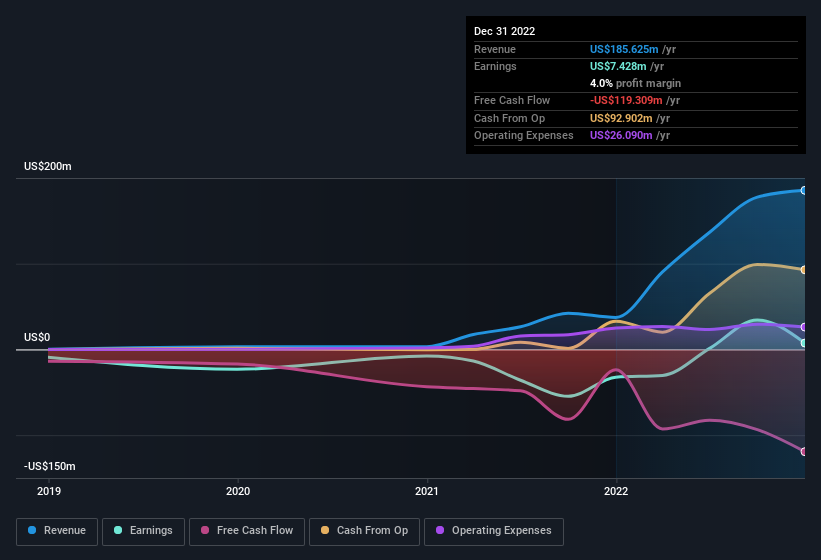- Canada
- /
- Oil and Gas
- /
- TSXV:ALPS.U
Alpine Summit Energy Partners' (CVE:ALPS.U) Earnings Are Weaker Than They Seem
Despite posting some strong earnings, the market for Alpine Summit Energy Partners, Inc.'s (CVE:ALPS.U) stock hasn't moved much. Our analysis suggests that shareholders have noticed something concerning in the numbers.
View our latest analysis for Alpine Summit Energy Partners

A Closer Look At Alpine Summit Energy Partners' Earnings
One key financial ratio used to measure how well a company converts its profit to free cash flow (FCF) is the accrual ratio. In plain english, this ratio subtracts FCF from net profit, and divides that number by the company's average operating assets over that period. This ratio tells us how much of a company's profit is not backed by free cashflow.
That means a negative accrual ratio is a good thing, because it shows that the company is bringing in more free cash flow than its profit would suggest. While it's not a problem to have a positive accrual ratio, indicating a certain level of non-cash profits, a high accrual ratio is arguably a bad thing, because it indicates paper profits are not matched by cash flow. Notably, there is some academic evidence that suggests that a high accrual ratio is a bad sign for near-term profits, generally speaking.
Over the twelve months to December 2022, Alpine Summit Energy Partners recorded an accrual ratio of 0.87. As a general rule, that bodes poorly for future profitability. To wit, the company did not generate one whit of free cashflow in that time. In the last twelve months it actually had negative free cash flow, with an outflow of US$119m despite its profit of US$7.43m, mentioned above. Coming off the back of negative free cash flow last year, we imagine some shareholders might wonder if its cash burn of US$119m, this year, indicates high risk. The good news for shareholders is that Alpine Summit Energy Partners' accrual ratio was much better last year, so this year's poor reading might simply be a case of a short term mismatch between profit and FCF. As a result, some shareholders may be looking for stronger cash conversion in the current year.
Note: we always recommend investors check balance sheet strength. Click here to be taken to our balance sheet analysis of Alpine Summit Energy Partners.
Our Take On Alpine Summit Energy Partners' Profit Performance
As we have made quite clear, we're a bit worried that Alpine Summit Energy Partners didn't back up the last year's profit with free cashflow. As a result, we think it may well be the case that Alpine Summit Energy Partners' underlying earnings power is lower than its statutory profit. The good news is that it earned a profit in the last twelve months, despite its previous loss. Of course, we've only just scratched the surface when it comes to analysing its earnings; one could also consider margins, forecast growth, and return on investment, among other factors. So if you'd like to dive deeper into this stock, it's crucial to consider any risks it's facing. Case in point: We've spotted 6 warning signs for Alpine Summit Energy Partners you should be mindful of and 2 of them shouldn't be ignored.
This note has only looked at a single factor that sheds light on the nature of Alpine Summit Energy Partners' profit. But there is always more to discover if you are capable of focussing your mind on minutiae. Some people consider a high return on equity to be a good sign of a quality business. So you may wish to see this free collection of companies boasting high return on equity, or this list of stocks that insiders are buying.
New: Manage All Your Stock Portfolios in One Place
We've created the ultimate portfolio companion for stock investors, and it's free.
• Connect an unlimited number of Portfolios and see your total in one currency
• Be alerted to new Warning Signs or Risks via email or mobile
• Track the Fair Value of your stocks
Have feedback on this article? Concerned about the content? Get in touch with us directly. Alternatively, email editorial-team (at) simplywallst.com.
This article by Simply Wall St is general in nature. We provide commentary based on historical data and analyst forecasts only using an unbiased methodology and our articles are not intended to be financial advice. It does not constitute a recommendation to buy or sell any stock, and does not take account of your objectives, or your financial situation. We aim to bring you long-term focused analysis driven by fundamental data. Note that our analysis may not factor in the latest price-sensitive company announcements or qualitative material. Simply Wall St has no position in any stocks mentioned.
About TSXV:ALPS.U
Alpine Summit Energy Partners
Operates as an energy developer in the United States.
Moderate with mediocre balance sheet.
Market Insights
Community Narratives



